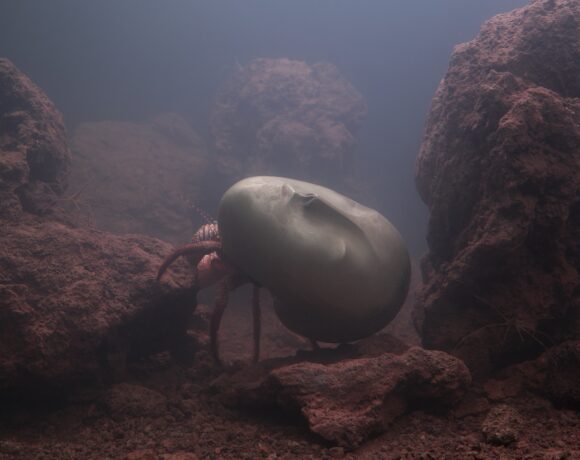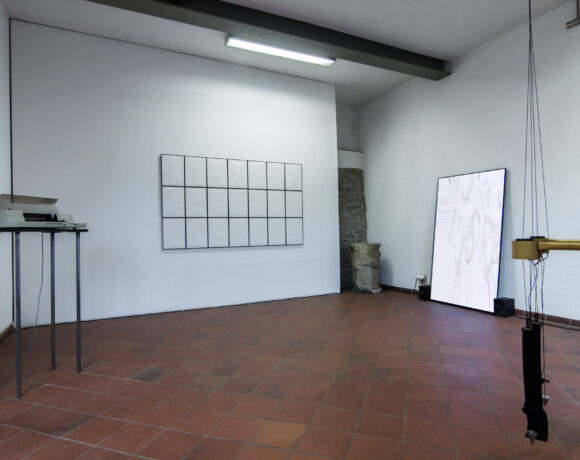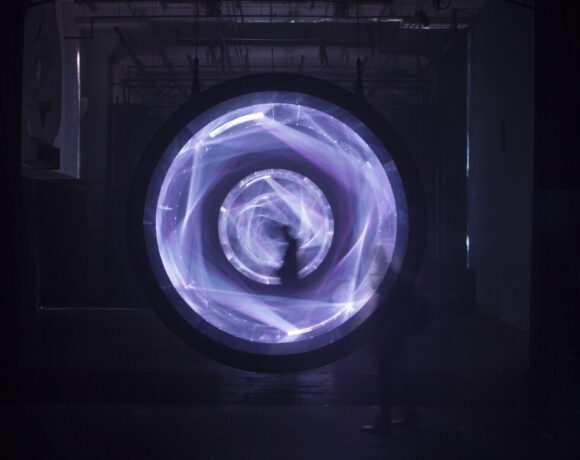Just thirty years old and already with an enviable cv. Born in Monfalcone (Gorizia), grown up between Friuli-Venezia-Giulia e Sicilia, Emilio Vavarella studied at the best Universities in Italy and abroad: from Bologna, Venezia, Jerusalem and Istanbul, to Harvard University in Cambridge where he is finishing his studies in Film, Visual Studies e Critical Media Practice. He recently won the Exibart Prize. We called him in order to talk about his second solo show at GALLLERIAPIÚ, born from the collaboration with Ramdom association and MAMbo in Bologna. This interview immediately turn to be a chance to deepen his artistic research in general, specifically based on the relationship between humans and technology, current more than ever.
Manuela Valentini: Your education path is rich and various: indeed, it goes from visual art to cinema, from digital arts to philosophy. How much important is a multidisciplinary approach in your work? And what do you think about marking out different fields?
Emilio Vavarella: A multidisciplinary approach doesn’t erase the differences between the various fields. It gives food for thought take place in-between them and it obtains answers that could gain the same values concerning different sectors. Than I am not interested in deleting the dividing lines belonging to several different areas. Instead, I am interested in the independent space linked to different disciplines in order to tackle specific topics and include specific methods. For examples, rs548049170_1_69869_TT (The Other Shapes of Me) is linked to scientific and technologic research as much as it is connected to philosophy, without getting subjected to each field’s limits. In this way I am allowed to work independently and to relate with different kind of audiences. What make me feel closer to the art world is the way of working always open to new methods and researches. My artistic investigation gather all my interests together. In this sense, to be an artist is a mandatory choice. At the same time, the kind of art as result of this process is inevitably multidisciplinary.
If I’m not wrong, your research is based mainly on the interaction between contemporary art and technological-scientific research. Since one year, mainly because of the social distancing, virtual experiences – as much as technology – draw a huge attention. How did you perceive this change?
My practice has always been focused on the relation between human beings and technology, and what recently happened concerning the global pandemic situation perfectly confirms technology will continue to be a main issue. This situation is a paradox and so it’s really interesting. Technology is central for most of our problem but still most of way to solve them are searched in the technological field. Why Is that? Most of the times technology is described as rational but it is the result of an ideological question. Where does this idea come from? Technology is considered as unnatural and unhuman, but if we think about it, humans are the only one able to create a technological development. Why are we denying what makes us what we are? These are topics I dealt in my last work since the very beginning. My last artwork rs548049170_1_69869_TT (The Other Shapes of Me) is the development of a deep reflection on technology as part of the life’s concept, both in a biological and philosophical way. I believe there will be a distinction’s crisis about technology and nature. The survival of the species, as the vaccines increase is showing us, could depend on our ability to intervene technologically on ourselves. For how long will we still consider technology as something different from nature?
Let’s go on talking about contemporary art/technology. How do you consider this relationship?
I can tell you how this relation is revealed in my work. It is always a question of investigating at the same time digital development, its possible application or malfunctions, its hidden workings, ideologies sustaining the evolutions. In 2012, I worked at Digital Pareidolia where I had the chance to study Facial recognition system’s malfunctions. If ten years ago this issue could be not that common, nowadays this technology is everywhere, from airports to supermarkets and our cell phones, having an influence on our daily lives. Furthermore, according to the numbers, important studies proved facial recognition system is based on databases full of prejudices and stereotypes, and the result is far from being neutral and increases bias and covering a fake objectivity. Still in 2012 I worked on my series THE GOOGLE TRILOGY, based on an idea of image-space, an image as virtual space. Today, my observations are more and more actual considering virtual reality and that most of our lives are filtered by digital screens. Another topic I analyzed starting from different points of view is the one tackling the relationship between technology and memory (MEMORYSCAPES, MNEMOGRAFO, MNEMODRONE, MNEMOSCOPIO). The memory’s topic is really fascinating in particular since I consider it as our subjectivity and identity’s basis. My attempt through my works is to give a shape to the mutual characterization of the relation between technology and who we are. Then, from 2017 onwards, I mainly focused on the issue regarding unhuman independence and mechanics creativity. Algorithms’ autonomy is the core subjects of works such as Do You Like Cyber? and Amazon’s Cabinet of Curiosities, and it has always been up for discussion even out if the more specific fields. I’m sure this topic also is going to be more and more central.
Most of your works start from a controlled project plan until your intervention leaves space to casual chances. For example, I am referring to The Other Shapes of Things, a project developed in two parts: Failed Objects and Datamorphosis. What are these two series about?
THE OTHER SHAPE OF THINGS is the title of two sculptural projects, still on-going, produced through heterogeneous technologies and techniques (3D scanners, 3D printers, data manipulation, ecc.). The first project, THE OTHER SHAPE OF THINGS- 1. Failed Objects (2017-ongoing), starts from a collection of hundreds of ‘failed objects’: 3D prints that I collected before they were destroyed by 3D printing labs all over the world. Each object is reproduced in series and the project is focused on the idea of fixing the errors through the revelation of new formal possibilities. The second project, THE OTHER SHAPE OF THINGS – 2. Datamorphosis (2019-ongoing), is composed by 15 sculptural series inspired by the 15 books that comprising Ovid’s poem The Metamorphoses. Forcing a computer to interpret Latin verses as coding instructions and map’s coordinates, each sculpture is produced in an new unpredictable way. I believe in our ability to accept unpredictability as a new generating energy.
Although you have already talked about malfunction ’s issue in your previous answer, I’d like to deepen the topic a bit further. In particular, I would like to discuss about The Google Trilogy, a project divided in three parts and related to the relationship between man, power and technological errors. One of these three parts is entitled Report a Problem: you traveled on Google Street View photographing all the “wrong landscapes” you encountered before others could report the problems and prompt the company to adjust the images. Where does this interest for errors come from?
There are several reasons that explains my interest. On the one hand, the error is often the result of unexpected events and, as already said, unpredictability is always generating energy (even when it breaks and destroys). On the other hand, the technological error often reveals the functioning behind a certain technology. In this way the error is an extremely useful tool to understand the functioning of technological power’s system around us. Then, I’d like to add that the error is related to unhuman creativity. When some years ago two Facebook’s chatbots started a dialogue between them using an invented language, researchers had ( and still have) different opinion on what happened: a programming error or artificial intelligence ‘s sign out of any human comprehension? Last but not least, the aesthetic appreciation. The error is an important source of formal innovation because it is completely unbound from our expectations.
As technology, also art should be used to improve our life or to solve some problems?
I like the idea that art generates some doubts, problems, not solutions. There are already branches of knowledge taking care of solutions and having artistic features – for examples architecture, design, city planning. To impose a specific function to the artist’s work would lead to an idea of predetermined set of aims. This would change art in a functional perspective. I prefer that the art’s function remains open and unclear instead, and that it changes from artwork to artwork. After all, practical solutions are as much important as utopic ’s visions or critiques to the system.
Let’s go back talking about rs548049170_1_69869_TT (The Other Shapes of Me). It consists in a huge installation based on the translation of your genetic code in a large fabric, through the labour of your mother, using one of the first modern computational machines: the Jacquard loom from the late nineteenth century. The title refers to the first line of text resulting from the genotyping of your DNA. The Other Shapes of Me exceptionally refers to the past ( althought pretty recent ), since most of the times your work studies the future. What is your approach to history?
I consider History always like something quite scary and endless charming. My first artwork, The Sicilian Family, was about the story of my family. Other of my works about memory, such as MEMORYSCAPES, MNEMOGRAFO and MNEMOSCOPIO, were connected to an idea of “personal history”, in plural and collective way. In my phd final dissertation at Harvard University I am dealing with a much wider historic research. Multidisciplinary and still ongoing, my final thesis is focused on the relationship between technology, thinking and the human’s concept in different moments of History. It’s a kind of history from a peculiar point of view and it’s an academic paper since this is the most appropriate medium for this type of work.
Ideas, thoughts look like fundamental to realize your works; some exceptions excluded, their production is pretty simple and quite cheap. Is it so? Would you define yourself as a “conceptual artist”?
Absolutely. As I already said in a recent interview, my main medium is thinking. The rest comes next. The materials shape our thoughts but they are low-cost, even the most challenging one.
What are you working on now? What about your future plans and in particulat, on which topic are you focused on?
I am working on a project for Premio Fattori Contemporaneo and another one for Exibart Prize. My schedule includes also a group show at Hermitage in Saint Petersburg and at MOMus – Experimental Arts Center in Salonicco. Then, I am working on two online projects I collaboration with the University of Milan and then Imago Mundi Foundation. Concerning the topic, I’ve always been fascinated by the concept of technological and media’s model. Machines and technologies has always offered models to understand “the human nature” and I am more and more focused on the way these models has deeply influenced people’s life. My phd dissertation, I told you about, is around this issue. What does “to be human” mean and what does it mean nowadays? How is it changing in this century and what remains the same? What kind of models of thinking and what kind of practices determine our future existence?
Manuela Valentini
Info:
 Emilio Vavarella, The Sicilian Family, 2012-2013
Emilio Vavarella, The Sicilian Family, 2012-2013
 Emilio Vavarella, The google trilogy 6_100, 2012
Emilio Vavarella, The google trilogy 6_100, 2012
 Emilio Vavarella, Do You Like Cyber, 2017, vista allestimento @ GALLLERIAPIÚ 2017
Emilio Vavarella, Do You Like Cyber, 2017, vista allestimento @ GALLLERIAPIÚ 2017
 Emilio Vavarella, The other shape of things_failed object, vista dell’esposizione, GALLLERIAPIÚ 2017
Emilio Vavarella, The other shape of things_failed object, vista dell’esposizione, GALLLERIAPIÚ 2017
 Emilio Vavarella, The Other Shape of Things_failed objects, 2017
Emilio Vavarella, The Other Shape of Things_failed objects, 2017
 Emilio Vavarella, The Google Trilogy – 1. Report a problem, exhibition view ‘That’s it’ @ MAMbo 2018
Emilio Vavarella, The Google Trilogy – 1. Report a problem, exhibition view ‘That’s it’ @ MAMbo 2018
 Emilio Vavarella, Amazon’s Cabinet of Curiosities, 2019
Emilio Vavarella, Amazon’s Cabinet of Curiosities, 2019
 Emilio Vavarella, Amazon’s Cabinet of Curiosities, 2019
Emilio Vavarella, Amazon’s Cabinet of Curiosities, 2019
 Emilio Vavarella, Datamorphosis, 2019. Foto di Stefano Maniero
Emilio Vavarella, Datamorphosis, 2019. Foto di Stefano Maniero
 Emilio Vavarella, rs548049170_1_69869_TT (The Other Shapes of Me), @GALLLERIAPIÚ 2021. Foto di Stefano Maniero
Emilio Vavarella, rs548049170_1_69869_TT (The Other Shapes of Me), @GALLLERIAPIÚ 2021. Foto di Stefano Maniero
For all the images: courtesy GALLLERIAPIÚ, Bologna

is a contemporary art magazine since 1980






NO COMMENT